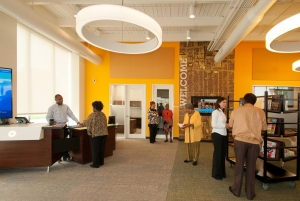Have You Asked Them What They Need?
Posted June 17, 2013
Corporate Social Responsibility vs. Community Partnership

Drawing on local knowledge to define and address a community’s challenges seems like a no-brainer. Who better knows the problems, past efforts, available assets, and potential talents than local residents? Yet, traditionally community engagement has not been the main approach for CSR efforts in the United States. Corporations have focused on what they can do for rather than with communities. A new initiative in Cleveland, the PNC Fairfax Connection, offers a new model for creating shared value through community partnerships.
From CSR’s roots in the late 60s to the present, we have moved from passive philanthropy to more proactive approaches that integrate CSR into overall business strategy. Corporations are finding that aligning the interests of all stakeholders delivers significant economic, brand, and cultural value over the long term. Goldman Sachs, for instance, commits not only money, but employees’ time and expertise to provide financial and management education and capital to entrepreneurs in developing countries. Similarly, the travel company G Adventures developed a women’s weaving cooperative in Peru. G Adventures brings its travelers to the cooperative to meet the women and buy their textiles. All parties benefit — the community, the travelers, and G Adventures.
Community partnership takes this idea to the next level — a corporation works with local citizens, government, nonprofits, and businesses to regenerate a financially struggling community to mutual benefit. The PNC Fairfax Connection demonstrates this model in action.
In 2010, PNC Bank asked ESI Design to help design a community center in Fairfax, a traditionally African-American neighborhood in Cleveland that had long faced economic hardships. PNC is extremely active in Cleveland and has strong ties to the city’s cultural, educational, and social nonprofit organizations. Unlike other CSR efforts, PNC and ESI agreed that this center should be designed not only for, but with community members.
PNC invited community leaders, including local pastors, small business owners, community college administrators, and staff from local nonprofits to identify needs within the community. Technology and job training, education, financial education, and a desire to preserve local culture and heritage topped the list. Greg Roberts, head of the Fairfax Business Association, expressed the urgency felt by many. He emphasized the need for training in the bio-tech, construction, and medical fields, saying “Workers here need to prepare themselves for the future or the future will pass them by.”
Working with PNC and the Fairfax community, ESI developed the physical and media designs for the center and the programs that addressed the community’s concerns. We envisioned the center as a communal hub — a connecting point for local residents, organizations, businesses, and PNC. We developed most programs in partnership with a local organization to strengthen and avoid duplication of efforts. The name itself reflects the bonds we hoped to forge.
To invite wider community participation, we held a series of pilot workshops that targeted every age group and encouraged intergenerational interactions. These included:
- PNC financial education for adults and small business owners
- A school-readiness program for preschoolers
- Community Scrapbook — participants scanned family photos and created digital scrapbooks
- Community Map — small business owners created listings and posted them on Google Places
- Media technology training workshops put digital video cameras in teens’ hands, then sent them out to videotape local choirs and interview the neighborhood’s oldest residents.
The pilot workshops piqued community interest. Awareness spread by word-of-mouth and built an audience long before the center’s opening in September 2012. The center now offers an extensive calendar of programs that continue to expand and evolve with ongoing feedback from community members.
PNC Fairfax Connection draws strength from its partnerships. While traditionally PNC has given financial support to many local NGOs, the new programs allow partners to bring their strengths to the table and meet on equal terms. New partnerships are on the horizon, including Cleveland Public Library, Rock & Roll Hall of Fame, and Cleveland Browns football team.
An assessment strategy built into the project will enable PNC to evaluate the Connection’s impact over time. Pre-opening employment and education statistics along with resident interviews yielded baseline metrics and information on awareness of the PNC brand. Over the next several years, the assessment will be repeated and the results compared to track change.
The PNC Fairfax Connection holds the promise of benefitting all parties. Fairfax residents have acquired an invaluable, free educational resource. Local nonprofits have found a good partner with strong management skills and the resources to invest in the community in a meaningful way. PNC Bank, in helping raise the economic opportunities of the community, is creating relationships with community members who will turn to PNC for their financial needs as they embark on new life ventures.
Hopefully, projects like the PNC Fairfax Connection will become models for other CSR efforts. Corporations partnering with community members and local organizations strengthen communities from within. Ideally, going forward the first impulse will be, “Let’s ask them what they need.”
Read more about the PNC Fairfax Connection.
This Blog was originally published in the Stanford Social Innovation Review, June 3, 2013.


Join The Conversation